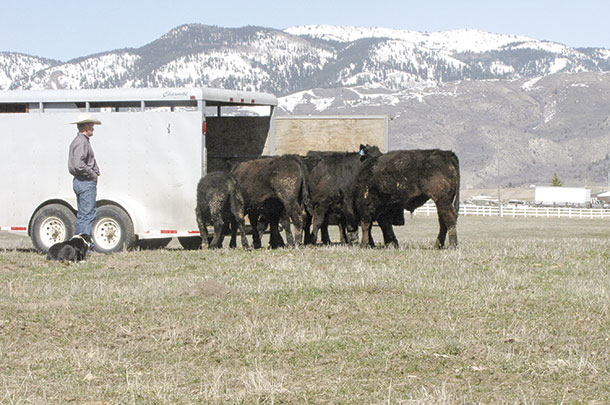The pack was in full attack mode, barking and biting any piece of bovine flesh they could get hold of. It was anything but low-stress cattle handling.
After conducting an after-chaos review, I realized the mistake I made was allowing a cowboy to bring his motley crew of dogs along on our weaning day gather of 500 to 600 cow-calf pairs. Before departing, I insisted everyone work to keep the cattle calm and quiet to minimize stress on the cattle.
Apparently, my admonition fell on deaf ears. Needless to say, we did not arrive back at the corral with a quiet, calm herd. Not to mention the precedent set for the work the rest of the day.
Pseudo-stockmen believe the best stockdog is one that has been selected to be more of an attack dog than a stockdog. It is unfortunate when cattlemen witness cattle being worked with a dog of this sort – one not ready or suited for working cattle appropriately.
It seldom goes well and understandably is usually a deterrent for many from using a dog to work cattle. But it doesn’t have to be this way.
The best stockmanship with a dog is attained when cattle are worked without raising much dust. Good stockmen understand this. They realize working cattle with a dog can be an effective method when precise procedures are followed.
They are aware of how different classes of cattle respond to dogs. Skilled stockmen also know there are definite characteristics of a superior stockdog, including being calm, confident and in control of itself. Anything less causes them extra work, money and frustration.
Working cattle effectively
Cattle tend to respond differently to the presence of a dog than to a human. When handled right, cattle will settle and become cooperative quicker than if we were to handle them without a dog.
For example, when gathering a couple of remnant heifers, I used a dog to settle and gain their control. Within a few minutes, the heifers were compliant to the dog’s directions; he and I then loaded them into the trailer in the open pasture.

When cattle are cooperative and easily controlled by a dog like this, the work is finished faster and with less stress on both cattle and personnel.
Stockdogs also help to diminish stress levels in cattle. This stems from their instinctive ability to positively manipulate cattle behavior. This can be particularly valuable with a group of fresh-weaned calves that have been overly stressed.
These calves may be walking and bawling excessively or huddled up in a corner of the pen. Either scenario is not healthy and will likely cause costly health problems. When done correctly, a dog can be used to get their minds thinking more about eating, drinking and ruminating naturally.
Working with different classes of cattle
In any livestock-handling situation, preparation is a key to success. Cattle that have been prepared to work with dogs are more apt to cooperate. Cattle properly introduced to dogs as calves or yearlings will likely accept a dog throughout their lives; this is often referred to as being “dog broke.” This is particularly important for heifers and yearling bulls joining the ranch herd.
Dog-breaking young cattle does not have to be difficult. I’ve had the most success starting with a small group in a small pasture or large corral. After this first group learns to move from the pressure of the dogs, additional calves can be added and conditioned correctly with minimal effort.
When introducing mature cows to stockdogs, it is best to do so when they are dry. Dry cows are usually quite responsive to the presence of a dog and will learn quickly to take his or her guidance. Bulls, when kept in a normal frame of mind, will also work well with a dog.
If handled correctly, cows with calves can also be successfully worked with the help of a stockdog. Often, simply having a dog present will encourage cows to find their calves and trail out as desired. Special care and attention is needed when using a dog to work cows with calves, especially if they have not had any prior experience with a dog.
Cows with calves should be worked by a confident, veteran dog that keeps a reasonable distance. Working from a distance and not over-pressuring the cow should persuade the cow to retreat.
If the cow does not respond, but advances belligerently toward the dog, the dog should stand its ground and use whatever pressure is necessary to correct the cow’s behavior. Discourage any barking; it only creates more commotion and escalates the problem.
Seeking the right traits
At one time, I raced sled dogs. As a novice to the sport, well-meaning individuals would make me a good deal on a sled dog. It was not long before I discovered those “good deals” were actually mediocre dogs most other people did not want. It was not a bad way to get started, but I soon learned it was difficult to be as successful as I wanted to be by using average dogs.
The same can also be true with stockdogs. Sometimes we start with what is available to us, but the best results are achieved when obtaining a dog proven to work cattle well. Finding this sort of dog can be difficult – but not impossible. The key is to take the time required to fully investigate any prospective dog; especially consider the dog’s lineage and natural instincts to work cattle.
There are two options to acquire a quality stockdog: purchase a pup or purchase an older started or finished dog. Purchasing a pup is less expensive initially, but remember, raising and training a pup takes a lot of time, expertise and experience.
Beginning with an older, proven dog that understands what is expected is an excellent option for anyone just starting to use a stockdog. Unlike a pup, an older dog is ready to be a help rather than a hindrance. Often, these older dogs are great teachers to the novice handler.
Before selecting an older dog, take sufficient time to see it at work in multiple situations. Watch for any behavioral issues that could become detrimental to your operation. An older, well-started dog should be calm and in control in most any situation.
An assertive dog will not be bothered when facing cattle head-on. The dog will only use force (bite) when needed and then release immediately. The goal is to have cattle that respond to the dog rather than react to it.
Too many dogs are allowed to be excessively rough and aggressive on cattle. Avoid these dogs; they do not promote stockmanship. A dog that constantly picks at cattle will only create wild, reactionary or uncooperative “dog fighters.” Such cattle become stressed and will get increasingly difficult to handle.
Whether you decide to start with a pup or an older dog, find a capable stockman willing to help you. Receiving help from someone knowledgeable and skilled at fusing stockdogs with cattle handling will be invaluable to you. A seasoned mentor will help you avoid certain pitfalls, enhance your knowledge, skills and abilities.
Conclusion
John Holmes, author of The Farmer’s Dog, wrote, “It is a pity so many general farmers still do not seem to appreciate the value of a good dog.” As I have worked with proven stockdogs over the years, I have certainly come to appreciate their value.
We only credit a fraction of what a veteran stockdog is capable of. Seasoned stockdogs can likely accomplish far more than what we are willing to entrust them with.
Achieving success is accomplished when a skilled dog is selected and when both the stockman and the stockdog work their cattle in an effective, relaxed and confident manner. Quiet handlers make for quiet dogs, which make for calm, easy-to-handle cattle. ![]()
PHOTO 1: Nunn’s stockdog, Spitz, quietly gathers and drives a small group of cattle.
PHOTO 2: The author, Les Nunn, and his stockdog ease cattle into a trailer out in open pasture. Photos provided by Les Nunn.

-
Les Nunn
- Extension Educator
- University of Idaho
- Email Les Nunn








